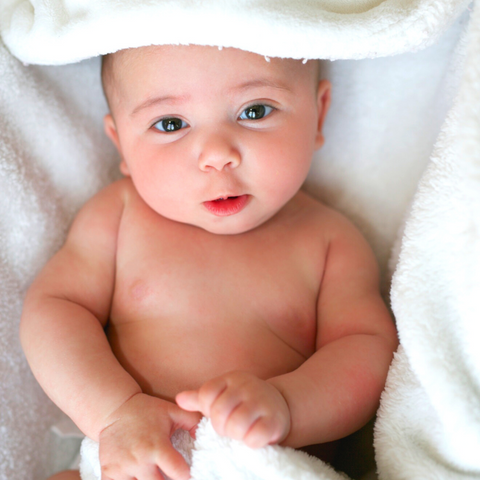All we every want to do for our little ones is what’s best for them, so when skin problems arise is can cause us to panic!
Learning & figuring out what works best for you and your little one is all part of the process, and with some clear and concise information we hope to help you along that journey.
In this blog post we will outline some of the common skin issues that can affect infants and how you can treat it.
Infants can develop several skin issues soon after entering the world, with three of the most common being: Eczema, Nappy Rash and Cradle Cap.
Eczema
Eczema and dermatitis are a general term used to describe several conditions causing the skin to become dry, itchy, and irritated. Eczema is an extremely common skin condition that can start from infancy, with over 80% of children developing it before the age of 6.
While eczema remains to be a very common skin condition, there is no solid cure or reason as to why eczema begins, with each person having varying degrees of eczema and different triggers.
Eczema can appear as red, dry skin, which can sometimes weep, become blistered, crusted and thickened. Although atopic eczema can affect any part of the body, it most often affects the hands, insides of the elbows, backs of the knees and the face and scalp in infants and children.
Eczema in infants can flare up from time to time, from being completely unnoticeable to very red and irritated. Monitor your daily routine and see can you eliminate triggers for your baby.
Triggers
- Home: Having a clean, ventilated home clear or any dust, animal hair or smoke
- Soaps & Detergents: Use a sensitive non-bio detergent when washing and a sensitive eczema specific wash when bathing.
- Heat: Keep bedrooms cool and well ventilated as heat and sweating can exacerbate symptoms.
- Clothes: Dress your baby in light breathable material & wear cotton where possible.
Treatments:
- Moisturising creams & emollients should be applied to the skin at least twice daily. Moisturisers should be gently smoothed in rather than rubbed. If using after a bath, the cream should be applied to the baby’s skin while it is still damp.
- Antihistamines can sometimes be given to reduce the itch and flare up, particularly if its effecting the infants sleep.
- Your baby’s fingernails should be cut short to avoid worsening an already irritated skin layer
- Occasionally, infections can develop. If the rash presents with any yellow-coloured crusting and scabbing, oozy skin, blisters or pus the infant should be referred to a GP.
Recommended Products
Nappy Rash
Nappy rash is one of the most common skin issues affecting infants. Nappy rash can present itself as slight redness and irritation to a breakout of blisters and pimples. Nappy rash can be caused by several things, and combination of things such as warmth, moisture and friction in the baby’s nappy.
Most nappy rashes can be treated by simply applying a thin layer of cream to create a barrier at each nappy change to protect the baby’s skin.
Triggers
- Dirty nappies should be changed as soon as possible.
- The entire nappy area should be cleaned gently with wipes that are fragrance and alcohol free.
- The baby’s skin should be dried gently & harsh rubbing and friction avoided.
- Nappies should be left off for as long as possible to let their skin breath.
- Harsh soaps & lotions should be avoided as it may contain ingredients that further irritate their skin.
Treatments
- For mild nappy rash simply apply a thin layer of cream at each nappy change to create a barrier for friction and irritation.
- For more severe nappy rash, a mild topical steroid such as hydrocortisone cream may be prescribed (Steroid creams should not be used for longer than 7 days)
- Fungal nappy rashes may occur when the skin is in prolonged contact with faeces and urine, as this can create a perfect environment for the growth. In this case, a topical antifungal cream would be recommended.
Recommended Products
Cradle Cap
Cradle cap is the name given to seborrhoeic dermatitis that affects the scalp in babies and young children. Cradle cap appears as yellowish, greasy scaly patches. It is a very common, harmless condition that does not usually itch or cause any discomfort to the baby.
Cradle cap is seen most commonly in babies during their first three months and tends to last a few weeks or months. The cause of cradle cap is not clear, although it may be linked to overactive sebaceous glands, which are glands in the skin that produce an oily substance called sebum.
Symptoms:
- Greasy yellow patches on the scalp
- Skin area appears red
- Scales and flakes on the scalp
- Yellow crusts on the scalp
Treatments:
- A small amount of oil such as olive oil or coconut oil can be massaged into the scalp and left on for 30 minutes.
- A soft baby brush or cloth can be used to gently remove any loose particles.
- Hair should be washed with a mild baby shampoo which will help to remove any scales that remain attached to the scalp.
- If the cradle cap becomes inflamed or infected, a course of antibiotics or an antifungal cream or shampoo, such as ketoconazole, may be prescribed by a doctor.
Recommended Products




